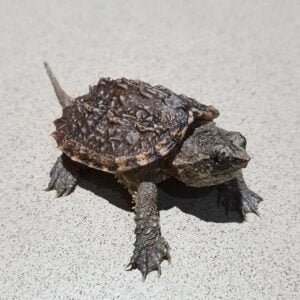No products in the cart.
Return To Shop3 Toed Box Turtles, a subspecies of eastern box turtle, is a relatively small terrestrial turtle with a high dome to the shell. Most individuals have a thin ridge on the centerline of the carapace. The plastron has anterior and posterior hinges and can close completely such that the entire body of the turtle is hidden. No webbing exists between toes, and the limbs are short. Adults are generally a uniform drab brown in coloration whereas juveniles often have light-colored (yellowish) spots near the center of each major scute on the carapace. However, some adults retain radiating light-colored lines on the carapace. The plastron is usually lighter in coloration and unmarked and is shorter than the carapace. Heads of adult males and females are often brightly colored with a combination of white, orange, or red. Males usually have red eyes whereas females usually have brown eyes. The three-toed box turtle may be confused with the plains box turtle, which is nearly identical in overall body form. The absence of radiating yellow lines on the plastron distinguishes the three-toed box turtle from the plains box turtles.














